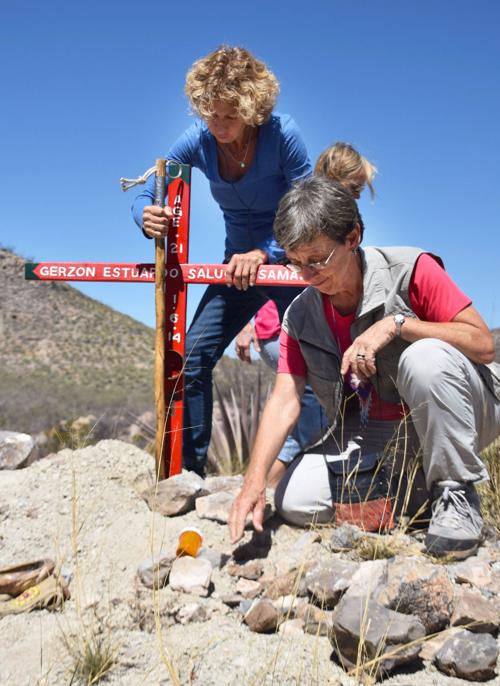They gather around a large red cross overlooking State Route 80 near Bisbee. The half-dozen people are here to honor the memory of Gerzon Estuardo Salucio Samayoa, a 21-year-old Guatemalan man who died nearby while crossing into the United States.
Despite a decrease in migrant crossings and Border Patrol apprehensions on the southern border, the number of bodies recovered from the desert remains high.
So far this fiscal year, which started in October, more than 50 bodies have been found. And the deadliest months for migrants are coming.
In fiscal year 2015, there were 21 deaths per 10,000 apprehensions in the Tucson Sector. That year alone, remains of 135 migrants were found in the desert, while the Border Patrol reported a little more than 63,000 arrests.
That’s more than double the rate in 2010, the deadliest year on record. Until 2007, the death rate for border crossers never exceeded 4 per 10,000 apprehensions.
Red and white crosses like Salucio’s are scattered across the Arizona desert, where volunteers led by Sister Judy Bourg of the School Sisters of Notre Dame in Douglas are planting one in memory of each body found in Cochise County.
“We are remembering, praying, calling to mind the spirit of the person who ended their life in our Sonoran desert,” Bourg said. “The crosses tell people that something terrible and special happened at that spot.”
Consequences of deterrence policies
Deaths in the Tucson Sector, which covers 262 miles of the U.S.-Mexico border from the New Mexico-Arizona state line to Yuma County, have decreased from more than 220 in fiscal year 2010 to 120 in 2014, data from the Pima County medical examiner show. The office handles remains found in Pima, Santa Cruz, Cochise and Pinal counties.
Since 2001, nearly 2,500 bodies have been found in the Border Patrol’s Tucson Sector alone.
While the number of deaths relative to the number of Border Patrol apprehensions has increased, there are limits to the comparison, experts warn, because the person could have died long before the remains were recovered.
“The date and time they are found is just that. We are reporting the number of remains found per year, not necessarily the number of deaths,” said Gregory Hess, Pima County’s chief medical examiner.
Though forensic archeologists assess skeletal remains to determine how long they have been in the desert, the window can be a period of several years, he said.
Migrant deaths in the desert are due largely to deterrence policies, said Ed McCullough of the Tucson Samaritans, who have been collecting data on migrant deaths since about 2004.
In the early 1990s, Border Patrol increased personnel and technology in strategic areas across the border, funneling migrants into more inhospitable areas, including the Arizona desert, he said. The idea was to decrease migration by making it harder and more dangerous to cross the southern border. But shifting border crossers to harsher, more remote areas also led to a greater number of deaths.
“Even if the buildup on the border has deterred some people, it isn’t worth the consequences to human lives,” McCullough said.
Each year, migrant deaths spike in June, July and August, when heat and lack of available water make trekking through the desert for days lethal, especially for border crossers who may not understand the difficulty and length of the journey.
Smugglers trick people, said Carlos de León López, the Guatemalan consul in Tucson. “They tell them it will only be a couple hours of walking. Then the reality isn’t what they were expecting.”
Many remains are never identified. But of those that are, Mexicans account for more than 80 percent of deaths in the Arizona desert, followed by people from Guatemala, El Salvador and Honduras.
Not only do smugglers lie to border crossers, but they leave migrants behind when they can’t keep up, De León said.
“Before they leave Guatemala to cross into Mexico, they need to understand the difficulties that are awaiting them,” he said.
Migrants make the journey from Mexico and Central America to the U.S. border for many reasons, but reuniting with family members and economic hardship remain the leading factors, De León said.
Desperation leads to taking risks, said Reyna Araibi of the Colibrí Center, which gets calls every day from families with a loved one who has gone missing after crossing the U.S.-Mexico border. Some can be tracked down in detention centers, in records of Border Patrol apprehensions or by identifying human remains, but many cases are never resolved.
Consulates, the medical examiner and the Border Patrol also collaborate with nonprofit organizations such as Colibrí and Derechos Humanos to identify deceased migrants, in hopes of giving families closure.
Still, most of the crosses Bourg and other volunteers place in the desert are “no identificado,” or unknown. Salucio is among the minority of crossers who could be identified and returned home to his family in Guatemala. More than a third of recovered bodies remain nameless, and an untold number are never found.
Gathered around the Salucio’s memorial, Bourg and the other volunteers each say a few words in offering to his life. Some express regret that he died so young. Some are reminded of their own children and send well wishes to Salucio’s family in Guatemala.
A few pray for policy changes that might prevent others from meeting the same fate.
For Bourg, “these people won’t be forgotten.”





